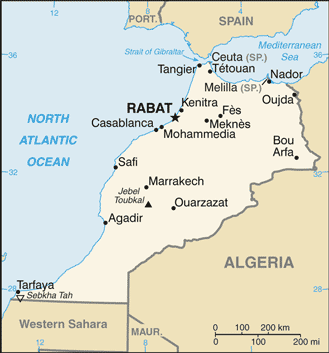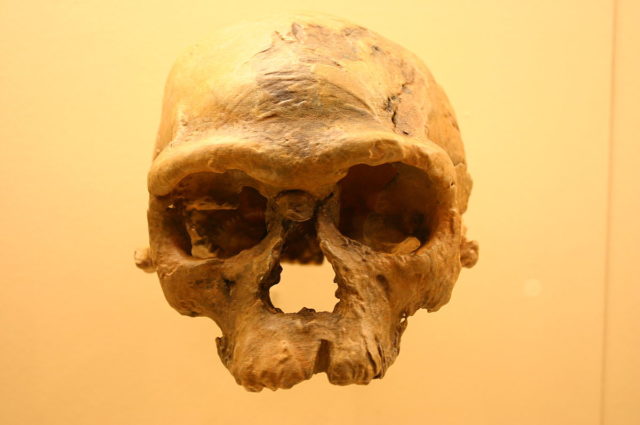Human fossils have recently been unearthed in Morocco that are 100,000 years older than fossils found in Ethiopia, which had been the oldest known remains to date. This discovery is gigantic, as it challenges the very foundations of the human evolution narrative, suggesting that modern humans did not originate 200,000 years ago in East Africa.
The fossil findings came from a mine in Morocco, at a site known as Jebel Irhoud. A former barite mine located some 62 miles west of the city of Marrakesh, it has been a place of ongoing excavations. Archaeologists realized the findings were ancient, but they were astounded when tests dated a tooth and stone tools at approximately 300,000 years old.

The excavation site is in a cave composed of 26 feet of deposits from the Pleistocene era and located in a karstic rock formation of limestone. It sits at an altitude of 1,844 feet. The area first caught the attention of the public back in 1960 when it was being mined for minerals.
It was a miner who discovered a skull in one of the cave’s walls when it was being cleared. His finding eventually reached the University of Rabat, and an expedition followed.

Within the first expedition, 30 species of mammals were unearthed at the site, some of which are from the Middle Pleistocene. By the end of the decade, 22 layers in total were identified in the ancient cave, the lower 13 of which were thought to contain signs of humans. The findings included various tools made of flint, such as blades, arrowheads, drills, and knives—tools frequently associated with Neanderthals.
A research team led by Prs Hublin and Ben-Ncer discovered the oldest Homo sapiens fossils at Jebel Irhoud, Morocco https://t.co/mD5D3jY8Oc pic.twitter.com/z28LEUYaQl
— Collège de France (@cdf1530) June 7, 2017
In those days, modern humans were believed to have evolved from Neanderthals. Now the Neanderthals are thought to have been a sister group that coexisted and even interbred with ancestors of the human.
As the cave findings were initially attributed to Neanderthals, new research reappraised the fossils, acknowledging they belonged to an archaic form of Homo sapiens, or at least a Homo sapiens group that interbred with Neanderthals.
Here’s a shot of Jebel Irhoud (l) vs La Ferrassie Neanderthal (r) that I didn’t use in the piece. Subtle diffs. https://t.co/kQNmUb70Sb pic.twitter.com/814Du2T7Lg
— John Hawks (@johnhawks) June 7, 2017
However, more crucial research carried out by the Max Planck Institute for Evolutionary Anthropology in Leipzig showed that the Jebel Irhoud site was much more ancient than first considered. Excavations from 2004, conducted by the team of the French paleoanthropologist Jean-Jacques Hublin, revealed remains of at least five people and a number of stone tools. The findings feature part of a skull, teeth, and a jawbone, as well as limb bones that reportedly belonged to three adults, an adolescent, and a child.
The earliest Homo sapiens bones, 300,000 years old, have been found in a mine at Jebel Irhoud, Morocco #Africahttps://t.co/6hY5QdER9c pic.twitter.com/ifQ8LXB8Rs
— QueensClassics (@QueensClassics) June 7, 2017
Analysis of the fossils suggested other intriguing possibilities. The lower jaw appears similar to that of a Homo sapiens, though much larger. A huge difference is the shape of the braincase, which is more elongated than that of humans today. According to Dr. Hublin, this comparison suggests how the modern brain evolved in Homo sapiens.
The fossils have similar features to the Florisbad Skull, dating 260,000 years back and found at the other end of the continent, in Florisbad, South Africa. Reportedly, the Florisbad Skull has now been attributed to Homo sapiens, based on the Jebel Irhoud finds.

Dr. Hublin has further stated that the team had expected the findings to be old, “but not that old.” He affirmed that the extreme age of the bones makes them, indeed, the oldest known specimens of modern humans. This largely challenges the theory that early humans diverged from another species in East Africa at a point 100,000 years later.
At the end of the day, the image of our species’ evolution may look completely different.
Bearing in mind the new evidence, the evolution track extends much further back. The process itself also seems to be different from what scientists previously thought. Humans might have occupied the entire African continent.
Just out | The age of the hominin fossils from Jebel Irhoud, Morocco, and the origins of the … #paleontology https://t.co/YwkO6bmADM pic.twitter.com/rbwttKq54E
— Paleowire (@paleowire) June 7, 2017
A crucial piece of evidence was the flint blades that show signs of having been burned by fire. This indicates that the people of Jebel Irhoud most likely used fire to cook food, supposedly heating damaged blades buried in the ground below. The flints have served as “historical clocks,” as Dr. Hublin and the team used a method called thermoluminescence to calculate the time that has passed since the blades were actually burned.
It is these calculations that led to the conclusion that the blades were as ancient as 300,000 years. In this context, the skulls found in the same rock layer must have been that very same age.
Newly discovered human fossils from Jebel Irhoud may represent the earliest evolutionary phase of H. sapiens https://t.co/E9kIzu6kd7 pic.twitter.com/QD3FAqgiDP
— nature (@nature) June 7, 2017
The flints are interesting for one more reason: Researchers have traced their origin to a site 20 miles south of Jebel Irhoud. Knowing how to search for resources over long distances, how to light a fire, and how to prepare food, the early Homo sapiens might have been a fairly sophisticated species that we still need more time and research to fully comprehend.
An analysis of stone tools found at the Jebel Irhoud site suggests the site is around 300,000–350,000 years old https://t.co/wXMAPJmxsl pic.twitter.com/nC1iwSRWpz
— nature (@nature) June 7, 2017
Similar flint blades of approximately the same age have been reportedly found at other locations in Africa and these have long puzzled scientists. As the research from Jebel Irhoud increases the chances they were made by early Homo sapiens, some scientists do not exclude the possibility the flints were created by other hominins, too.
From all the evidence and opinions, we can determine that both in Africa and globally, our evolution was likely made possible by different species that all coexisted at the same time and likely occupied the same living spaces.
